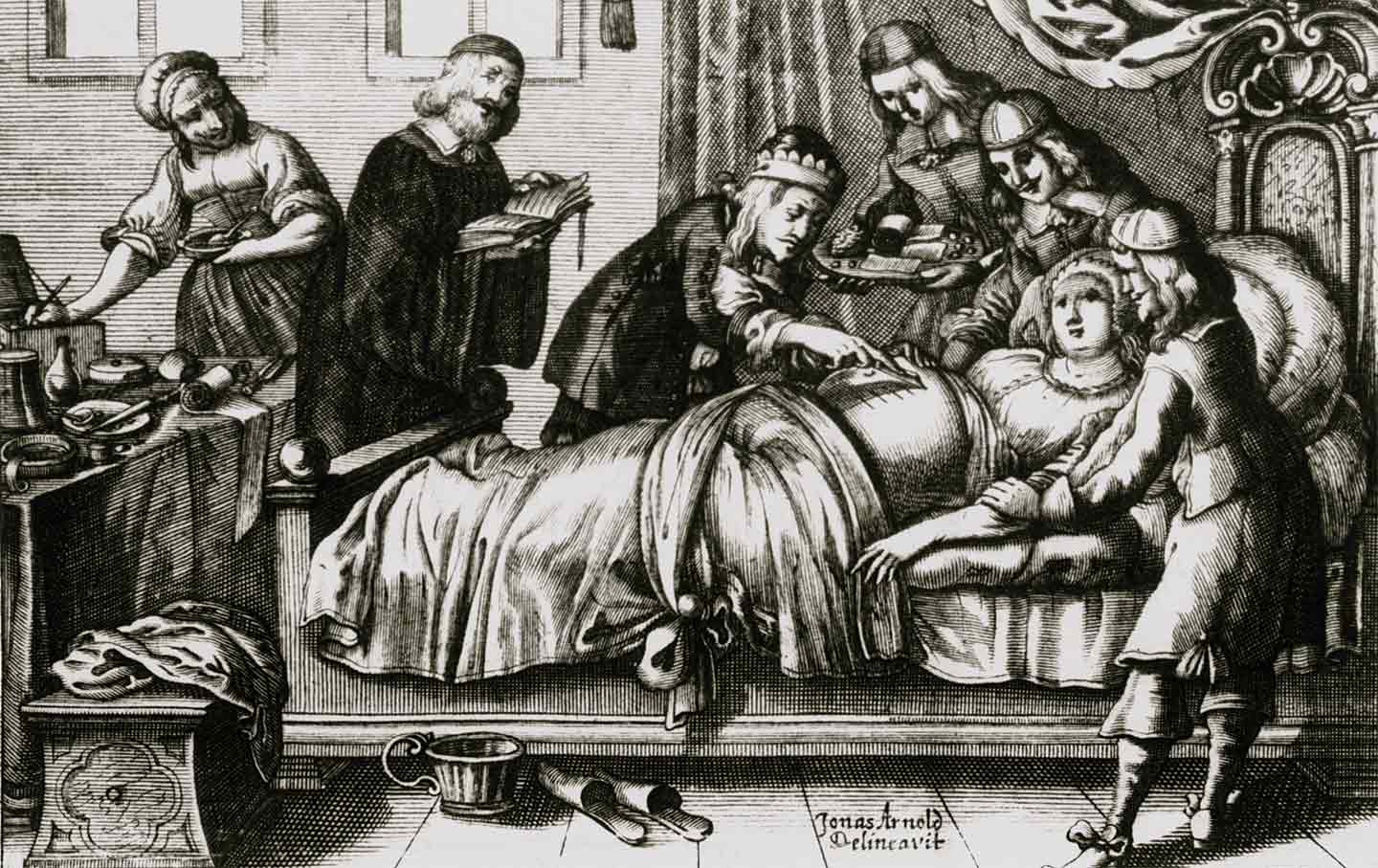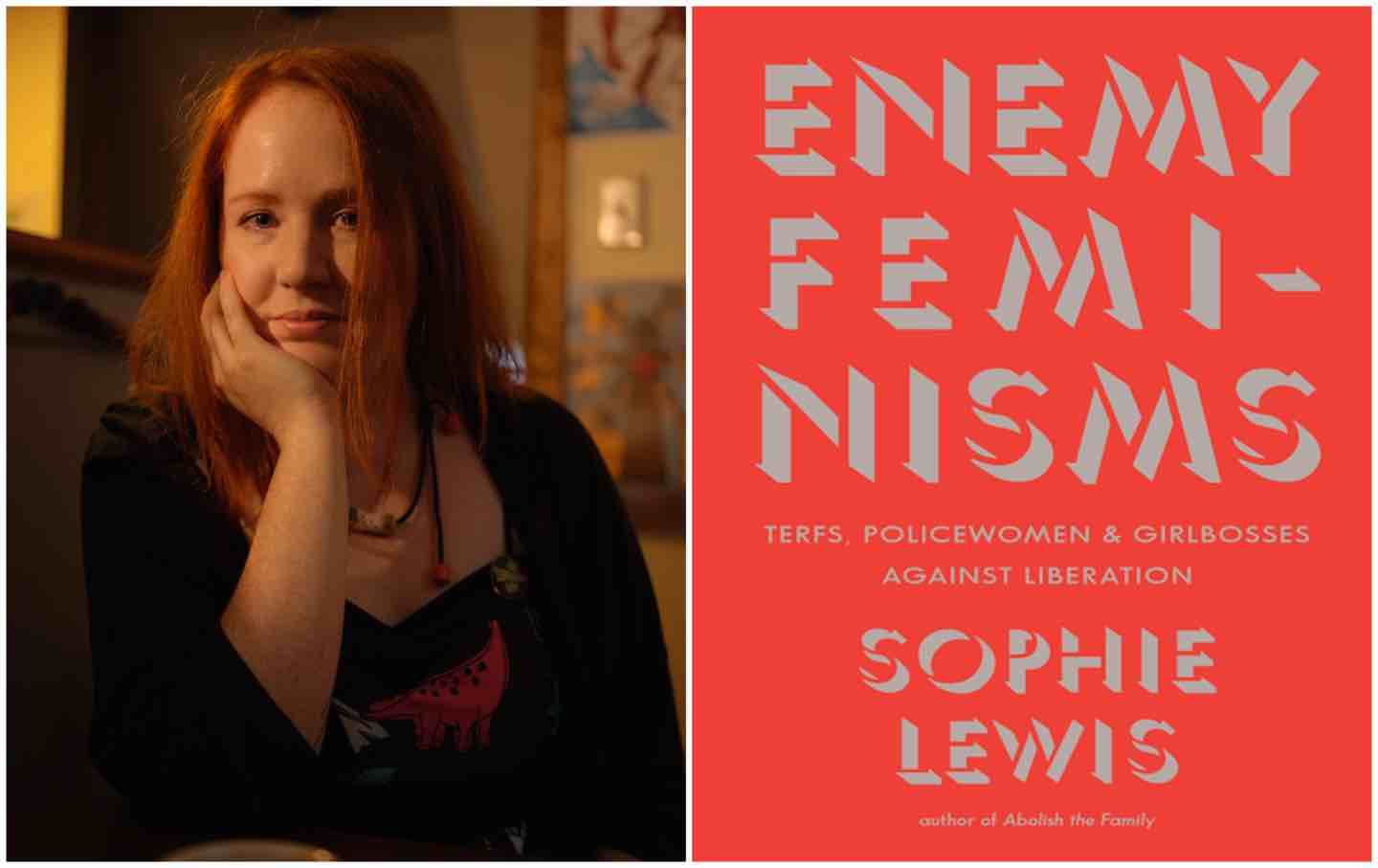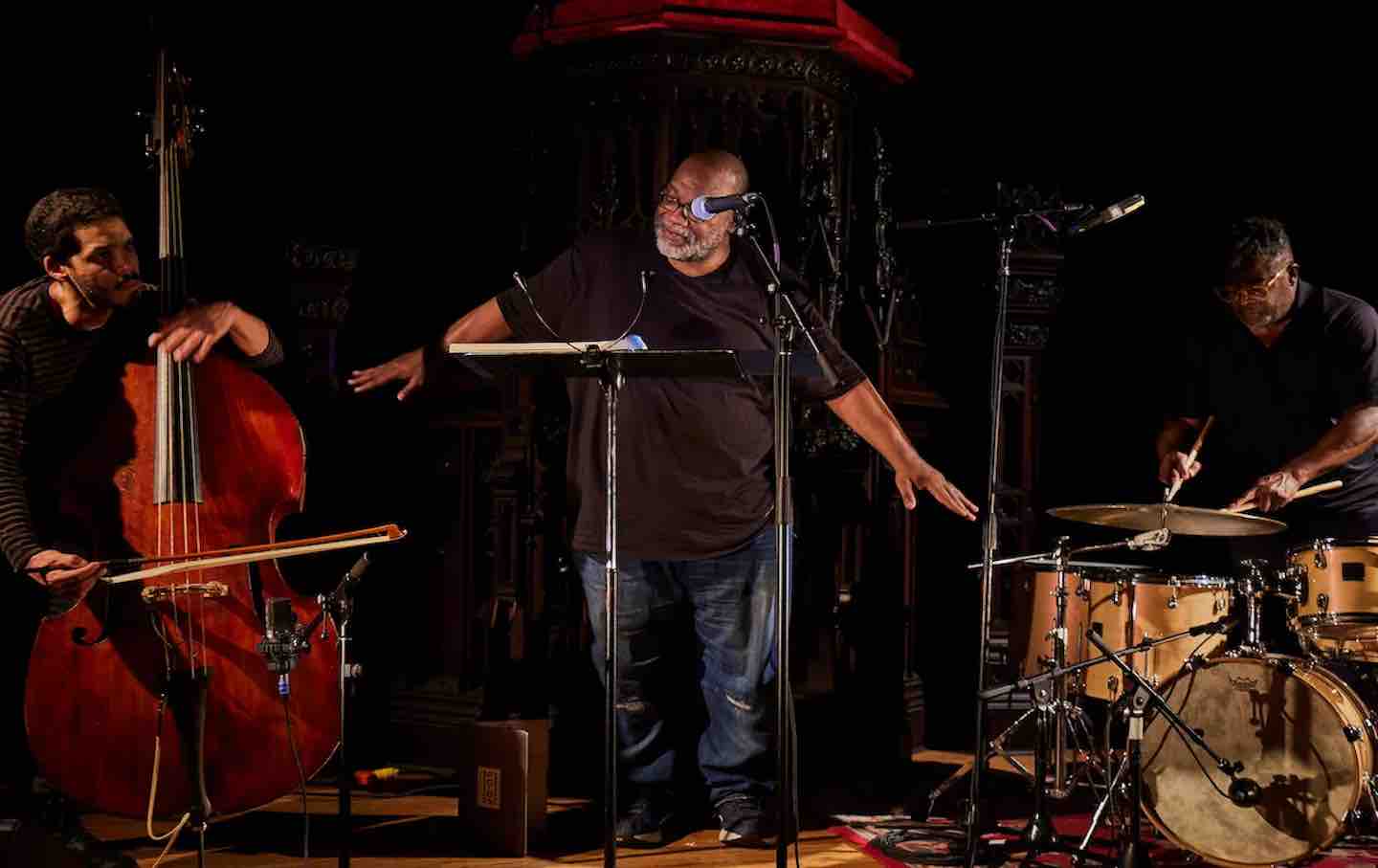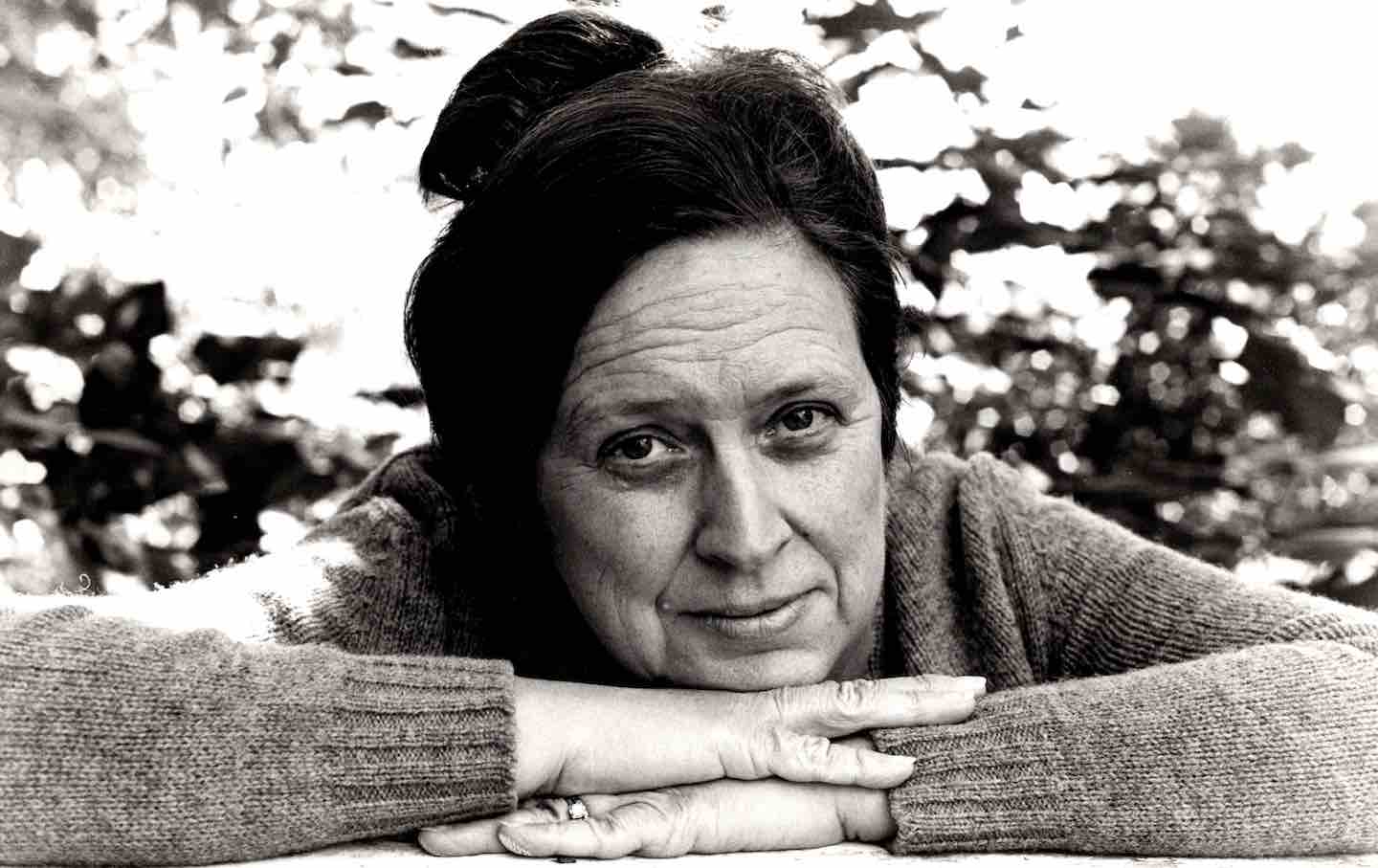More Than a Natural Function
The politics of birth.
The Dubious Feminism of the Natural Childbirth Movement
Though it responds to a justified distrust of the medical establishment among women, it also subtly partakes of an insidious mythology.

Pregnant women are everywhere, but in a way it’s hard to see them. The pregnant woman’s body is shrouded in a veil of symbolism, made an object of our anxieties and hopes in a way that’s distinct and intense even when compared with the various other ways we objectify woman. When people look at a pregnant person, they often don’t see a human being so much as a series of abstractions related to pregnancy: “maternity,” “nature,” and “creation” in all their gauzy allure. They see a vision, colored by ideology, of what has long been presumed to be women’s destiny. In some tellings, childbirth is the act by which the mother comes as close as a human can be to a god; in others, it’s the moment where she is revealed to be an animal after all. But most understandings of childbirth depict it as somehow fated, the fulfillment of an ancient and even sacred human function. Childbirth, we are given to understand, is the culmination of the mother’s humanity, the moment in which she fulfills her highest biological and social purpose. These are not necessarily bad beliefs—at least, they do not appear ill-intentioned. But they have the unfortunate effect of obscuring what might be the most important aspect of pregnancy and childbirth: that they are done by real human beings—women, mostly—with minds and needs of their own.
Books in review
Birth Control: The Insidious Power of Men Over Motherhood
Buy this bookAllison Yarrow’s new book, Birth Control: The Insidious Power of Men Over Motherhood, seeks to correct some of our misconceptions about the process of birth. Offering an account of labor and delivery practices in contemporary America, the book is also something of a manifesto for the natural childbirth movement.
Yarrow points to a crisis in American childbirth. C-sections are common; pregnant women fear pain or even death during delivery and so seek out medical intervention. Our biology has been misunderstood, Yarrow says, often for misogynistic reasons, and women’s bodies are often blamed for difficult pregnancies or birth complications. Sometimes, doctors impose their own judgments about what is best in childbirth, and for the scared and vulnerable woman in the maternity ward, this can be painful, violating, confusing, even degrading.
How has American childbirth gone so wrong? Yarrow asks. How have hospitals, doctors, and the obstetrics field more generally acted on a set of reductive assumptions and misogynistic myths about women, pregnancy, and childbirth in ways that make the act of bringing a child into the world more dangerous, painful, and frightening than it should be? Yarrow embarks on a mission to uncover the ways that the medical system fails the people she refers to as “birthers”: scaring them, curtailing their options, and, in Yarrow’s view, imposing unnecessary medical interventions. Yarrow is appalled by the terror and pain that many women feel during childbirth; she wants labor and delivery to be a peaceful, joyous experience, and she is determined to find out why it isn’t. In this project, Yarrow is often lucid, righteously angry, compassionate, and moving.
But after Birth Control’s inquiry into the sexist failures of the medical system, Yarrow eventually moves on to a broader condemnation of the field of obstetrics itself and espouses a near-absolute faith in the ability of the female body to deliver safely on its own. Ultimately, she comes to oppose just about every medical intervention related to childbirth. Her vision precludes the use of epidurals, looks down on hormonal birth control, and decries everything from induced labor and C-sections (including in cases of breech) to the hospital setting and, ultimately, the involvement of doctors itself. Her solution instead is unmedicated home birth with the assistance of a midwife. Taking its cues from the nearly century-old natural childbirth movement, Yarrow’s book advances a vision that downplays the complications of pregnancy, waves away the high rates of maternal mortality in the pre-medicalization era, insists that the pain and fear felt by women in labor are psychosomatic or are caused by the very medical interventions meant to help them, and claims that childbirth is hardly ever complicated or dangerous enough to warrant the presence of a doctor.
These are the book’s empirical claims, but Birth Control also makes a set of moral ones. Not only is childbirth low-risk, Yarrow argues, but it is, for women, a natural fulfillment of their biological destiny—an opportunity to become their truest, most fully realized selves. “Childbirth is the most powerful moment of a woman’s life,” Yarrow writes, approvingly citing the British birth advocate Sheila Kitzinger. “A woman meets herself in childbirth.” It follows that such a spiritually significant event is too important to be mediated by things like birth control pills, medical expertise, and pain medication. Giving birth isn’t dangerous, Yarrow tells us, and you don’t need a doctor to help you do it. If you’re scared, it’s because you’ve been brainwashed; if it hurts, it’s because you’re rushing things and don’t trust your own body. Your body knows what to do—not your mind. In this way, Birth Control not only offers a critique of the troubling history of sexism in the medical profession; it also partakes of the subtler and more insidious mythology of biological destiny advanced by the natural childbirth movement—one in which the story of pregnancy, birth, and motherhood carries with it clear prescriptions about what women and their bodies should do and be.
Birth Control comes out swinging against the med-ical profession, and it advances the arguments of the natural childbirth movement in what is perhaps a uniquely inconvenient political moment. Although the medical risks of pregnancy can be a tangential concern for the vast swaths of the public who are not currently pregnant themselves, law and reality have now merged to make the very real dangers of pregnancy and birth newly visible. In 2023, one year after the Supreme Court’s decision in Dobbs v. Jackson Women’s Health Organization, the rapid proliferation of abortion bans with no practicable exception for the life or health of the mother has made the difficulty and danger of pregnancy and birth brutally clear. Maternal and infant mortality rates are rising. Women are being denied abortions even as their miscarriages give them sepsis; they are also being forced to develop preeclampsia, or gestational diabetes, and subjected to births that lead to life-altering injuries.
Though Yarrow points to an excess of medical intervention as the cause of the sorry state of American childbirth, these catastrophes have been caused by too little access to care—too little respect for women, too little freedom for doctors, and too little choice. Pregnancy and birth, it turns out, are very dangerous, made more so by the misogyny and inequality that cut off access to the effective treatments that save lives. In this context, the natural childbirth movement’s assertions that pregnancy and birth are safe, and that their medicalization is nothing more than the nefarious project of what Yarrow calls “a profession founded on fear of the generative power of the birthing body,” are a bit difficult to swallow. If birth were so safe, and medical care so unnecessary, then the removal of that care—its prohibition and constraint under misogynistic laws—would not have resulted in so much human pain and loss. Every day, another tragedy emerges in the news to prove this fact again.
This is not to say that the natural childbirth movement is entirely wrong in its critique of medical providers. Indeed, Yarrow takes her cues from a long feminist tradition of challenges to medical authority, one best exemplified by the collaborations of Barbara Ehrenreich and Deirdre English. Their 1972 pamphlet Witches, Midwives, and Nurses, one of the most influential texts of feminism’s second wave, describes how delivering infants had traditionally been women’s work—that is, until the 19th century, when the practice of medicine became professionalized and the emerging male-dominated field of obstetrics took a dim view of its competition. Yarrow tells a similar story in Birth Control: Two parallel tracks of childbirth care developed with the stigmatization of midwifery in the 19th century—one of credentialed, professional doctors, mostly men, and the other of uncredentialed, nonprofessional midwives, mostly women. Sensing competition, doctors embarked on a years-long lobbying campaign to penalize, stigmatize, and ultimately outlaw much of midwifery. And it worked: By the 20th century, births were increasingly being conducted under the care of male doctors, not female midwives, and more and more of them took place in hospitals. But obstetricians did not learn from the experience and expertise of midwives; instead, they looked to standardize and innovate in childbirth care and set about reinventing the wheel. Women in labor tended to suffer because of it.
This history is real, and in terms of the human suffering involved, it is also chilling. Medicine, like every site of institutional authority, has a long and horrible history of enforcing gender hierarchy through violent means. So when the natural childbirth movement asserts that medicine has frequently been used as a legitimating pretext for women’s violent oppression, it has history on its side.
But the righteousness of the natural childbirth movement’s complaints about exploitation and callous disregard by doctors can obscure the sometimes dubious empirical claims it makes about medical outcomes, or the essentialist and unsupported assumptions about women that motivate its reasoning. For one thing, the obstetrics field has changed dramatically since medicine was professionalized, and many of those changes have made obstetric practice and maternal care kinder and more skilled. For example, Yarrow spends a good deal of time decrying the use of episiotomies—surgical cuts made to the perineum during birth to create a larger opening for the baby to pass through. These cuts were painful and often conducted without the woman’s consent; sometimes, they were used to hasten birth when a bit more time and patience would have allowed a successful delivery without the painful and invasive genital incisions. But for all the horror of the episiotomy, the reality is that the procedure is only rarely practiced now. Its use began to decline in the 1980s, as a growing body of data showed that the incisions did not yield the beneficial outcomes they were believed to have, and in 2005, a definitive study disproving the supposed benefits of episiotomies led to a dramatic drop. Hospitals and ob-gyn departments respond quite well to empirical evidence, even if they do not respond as well as one would like to women’s own testimony.
Demographic changes in the field also make the natural childbirth movement’s narrative of male doctors exploiting female bodies—or, as the subtitle of Yarrow’s book puts it, “The Insidious Power of Men Over Motherhood”—not quite as straightforward as its advocates insist. Throughout Birth Control, Yarrow uses the word “men” as a stand-in for “doctors,” a move meant to contrast the so-called masculine empiricism of medicine with the supposedly feminine realms of intuition, tradition, and superstition that are favored by the natural childbirth movement. It’s a rhetorical move that obfuscates reality in more ways than one. For starters, the obstetrics field is now dominated by women. Perhaps no field of medicine has been transformed so quickly and completely in its gender composition: In 1970, just 7 percent of gynecologists were women; in 2018, 59 percent were. The field is likely to become even more female in the future. According to a 2015 report by the Association of American Medical Colleges, about 85 percent of obstetrics residents are women, a trend that is due in no small part to patient demand: Women tend to prefer female obstetricians and increasingly have the power to request them.
The term “natural childbirth” itself is nearly a century old. It was likely coined by the British obstetrician and World War I veteran Grantly Dick-Read in his 1933 book of the same name. Dick-Read believed that childbirth was not an inherently painful process; instead, the pain was caused only by women’s fear—an anxiety that caused them to clench their muscles—which Yarrow calls the “fear-tension-pain theory.” Dick-Read set out to change British childbirth, encouraging women to abandon medical interventions in order to achieve a supposedly more authentic birth process. For him, this primarily meant forbidding pain medication for women in labor. This point—the rejection of pain relief—is still the natural childbirth movement’s main tenet, the factor that separates a “natural” birth from an “unnatural” one.
Yarrow quotes Dick-Read at length, and any account of the natural childbirth movement’s history would be incomplete without him. But she is ambivalent about him, making it clear that she can find him off-putting. Dick-Read’s book “can feel pejorative and coddling,” she writes. “[He thinks] women’s purpose is to give birth.” (An odd complaint, given that Yarrow’s book makes similar claims, but Birth Control is not a work of great consistency.) It likely doesn’t help that Dick-Read came to advocate natural childbirth for the purpose of eugenics: He believed that the “over-civilized” women of Britain’s upper classes—those he found most genetically desirable—were not breeding enough because they had developed a pathological fear of pain during labor. He compared these women unfavorably with the “primitive” women of other countries, who allegedly did not fear childbirth; he praised, too, the poor and ignorant women of the London slums, who he said gave birth without medical assistance, complaint, or even basic hygiene. “There was no soap or towel; Dick-Read brought his own,” Yarrow writes of a delivery he performed in one such slum. “There was ‘no fuss or noise,’” she adds, quoting the doctor himself.
Popular
“swipe left below to view more authors”Swipe →But Dick-Read’s solution for the upper-class women he hoped would breed more was not to give them pain meds so they would stop suffering in labor and hence stop fearing it. Instead, his solution was to inform them that natural childbirth would not hurt and that the pain they had felt was only because they were doing it wrong. “Fear of birth pain produces the real thing,” Yarrow explains. If pain is psychosomatic—merely the product of a woman who doesn’t trust her body enough—then the answer is not to treat the pain, but to fix the woman. “The solution to the syndrome, Dick-Read proposes, is to ‘relieve tension and to overcome fear in order to eliminate pain,’” Yarrow writes. “In other words, the work of eliminating labor pain is in the mind.”
What is the natural childbirth movement’s approach to labor pain? Judging by the most prominent movement leaders cited in Yarrow’s book, the approach is simply to deny it. People like Dick-Read argued that labor pain was only the result of women’s “over-civilization.” Yarrow herself maintains that most labor pain is caused by Pitocin, a labor-inducing drug, rather than by the contractions of the uterus, the dilation of the cervix, or the descent of an infant through the vaginal canal. Others in the movement seek to sentimentalize labor pain by describing it in cloying, mystical, or schmaltzy terms. “The power of birth is like the strength of water cascading down the hillside, the power of seas and tides, and of mountains moving,” Yarrow quotes the British midwife Sheila Kitzinger as saying, which I guess is one way to put it. Yarrow also reports that “painful isn’t the word I use to describe my three natural childbirths.” Good for her.
In Birth Control, Yarrow justifies the natural childbirth movement’s opposition to pain relief for women in labor by alternately claiming that the use of pain medication leads to C-sections (although it does not) and that unmedicated labor pain is mostly psychosomatic, all in a woman’s head. In this sense, the movement resembles nothing so much as the medical misogynists it decries: gaslighting women by insisting that their pain is nothing more than the product of their own anxiety. Yarrow also denounces those religious traditions that have depicted labor pain as a punishment for the sins of Eve. But from the very start, the natural childbirth movement has also framed labor pain as a result of women’s inadequacy, their unwillingness to just get over it. Labor pain, the movement suggests, is something that happens only if you’re scared of what your body is meant to be doing naturally. If you’re not thinking of your labor in sufficiently optimistic terms, or if you don’t love your baby enough, or if you’re simply not enlightened enough, you feel pain. But if you’re good, kind, loving, and wise—someone who trusts nature and her body and is not too civilized to resist them—then you don’t.
A decade after Dick-Read’s death, the natural childbirth mantle was taken up by the woman who can be called the true founder of the modern American movement: Ina May Gaskin. Now 83, Gaskin is a midwife whose first book, Spiritual Midwifery, became a sensation when it was published in 1975. Other books followed: Yarrow calls Gaskin’s 2003 book, Guide to Childbirth, “perinatal required reading.”
Gaskin was the countercultural matriarch of a rural Tennessee commune called the Farm, which was founded in 1971 by a group of some 300 hippies who had left San Francisco in a caravan of school buses to seek a promised land. The Farm was the kind of spiritual community that leads outsiders into debates about whether it was technically a cult. The group was led by Stephen Gaskin, Ina May’s husband, who wanted to build a community based in part on the revelations that he’d experienced while high on LSD. The Farm was generally suspicious of law, science, medicine, and authorities other than Stephen. To join, members had to accept him as their leader and hand over all their money. They practiced plural marriage and collective breastfeeding; Stephen prohibited divorce, abortion, and birth control. The Farm produced a small commercial crop of soybeans—and a lot of babies.
Under these conditions, Ina May became a skilled midwife, even though she never studied nursing or had any formal medical training. Gaskin opened a birthing center on the Farm, where members and nonmembers alike could deliver their babies. What Yarrow does not disclose is that, in order to discourage abortion, the birthing center advertised that the Farm would, if asked, take in and raise the babies of women who gave birth there. Ina May used no painkillers during delivery; over time, she became famous for the “Gaskin maneuver,” a method of positioning a laboring woman on her hands and knees with one leg bent forward, like a runner’s stretch, which has become widely used to correct shoulder dystocia without resorting to C-sections. (Gaskin claimed that she learned the move from Indigenous Guatemalan women.)
Like Dick-Read, Gaskin decries pain relief as insufficiently “natural” and suggests that labor pain can be alleviated by a woman’s efforts to change her state of mind. Unlike Dick-Read, however, Gaskin did not tell women to just grit their teeth and bear it, but instead invited fathers into the birthing process, encouraging them to, among other things, French-kiss their partners during labor and to issue encouraging platitudes. “At one birth she attended, a husband repeatedly told his wife she was ‘marvelous,’” Yarrow writes of Gaskin’s midwifery practice. “The woman believed that the words opened her cervix and invited the baby out.”
It is lovely that the mother believed this. But should we? Yarrow seems to think so. The natural childbirth movement is perhaps aptly summarized by this little vignette, with the laboring woman virtuously forgoing painkillers and proving her worthiness, femininity, and proximity to nature by delivering a child without any help other than assurances from the man who impregnated her that she is “marvelous.” Yarrow and the rest of the movement routinely insist that they only want to fulfill women’s own desires regarding childbirth. But this is a polite fiction. The truth is that the natural childbirth movement is prescriptive and highly judgmental: It posits an ideal birth and then imagines the kind of woman who achieves it. Yet if a birth involves painkillers, or fear, or a need for medical intervention, or even an acknowledgment that it hurts, then that birth, and the woman who goes through it, are necessarily less than ideal—i.e., flawed. In that sense, the natural childbirth movement, which so nobly seeks to free women from the degradation and hurt that they endure at the hands of doctors, often begins to look less freeing than cruel.
It is curious that Yarrow, for all her praise of Gaskin, does not mention the midwife’s most distinctive contribution to the philosophy of natural childbirth: the theory popularized in a 2008 documentary, Orgasmic Birth: The Best-Kept Secret. Gaskin claims that if childbirth is done correctly, with sufficient stimulation from the father and an appropriately enlightened state of mind in the mother, women will climax as they deliver. Patriarchy’s various demands on women—to be caring, self-sacrificing, sexy—are thus distilled into one gruesome image. Compelled to be simultaneously earth mother and sexpot, the laboring woman is not relieved of sexual responsibility even when giving birth: She is expected to achieve an orgasm—or, at least, to perform one—even as the infant tears its way out of her. There’s a word for this, but it is not “liberation.”
The truth about childbirth—that it is dangerous; that it is complicated; that things can go very wrong without warning; that it really, really hurts—are things that the natural childbirth movement’s most ardent proponents must talk around and deny in order to have their worldview make sense. “There is no physiological function in the body which gives rise to pain in the normal course of health,” Dick-Read asserts, as if that settles the matter. Yarrow agrees: She frequently speaks of the “design” of women’s bodies—though without saying who designed it—and insists that this design cannot be flawed and should not be tampered with.
This brings us to the most troubling suggestion made by the natural childbirth movement: that giving birth is what women are for—their bodily destiny, their logical purpose, and in some sense their highest reason for being. It is here, in its rapturous faith in women’s reproductive role, that the movement begins to sound like the anti-choice zealots whose regressive and sexist ideas about pregnancy and childbirth now carry the force of law. As Yarrow asserts in a chapter called “Childbearing Hips,” women “[need] more stories that acknowledge the truth: we were born to birth.” Although Yarrow is pro-choice, how different is this contention from the one offered by the anti-choice extremist Laura Strietmann, who argued that pregnancy is not really dangerous even for little girls impregnated as the result of rape, because “a woman’s body is designed to carry life”?
Women are not “designed” objects; they are not mere vessels for the reproduction of humanity or animals marching toward their natural destiny. They are people—thinking, feeling, and intelligent human beings, even while they give birth. The natural childbirth movement is responding to a real concern: the justified distrust of the medical establishment by women and their reasonable discomfort with many of the ways that labor and delivery are—and historically have been—mismanaged and misunderstood. But practitioners like Dick-Read and Gaskin do not alleviate the suffering of women in labor. They simply deny it, burying it under layers of romanticizing naturalization, like so many paisley scarves.
None of this really helps the people it intends to help; it only adds yet another unreasonable expectation that women will fail to live up to. It is Yarrow’s great virtue that she feels immense loyalty to women in labor. She has been as vulnerable as they are—scared and uncertain, navigating disrespect from doctors and the morass of postpartum life; her empathy for them, her desire to protect them, is searingly evident on the page. She wants to save laboring mothers, to show them a better way. But the natural childbirth movement, with its embrace of regressive myths about women and its insistence on the nonreality of their pain, is not the better way Yarrow seeks. Women—mothers—deserve better than its patronizing sentimentalization of their physical pain. They deserve competent medical attention. They deserve sensitivity and respect. And they deserve the good drugs.








